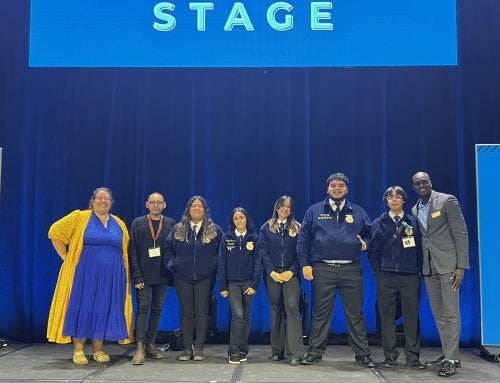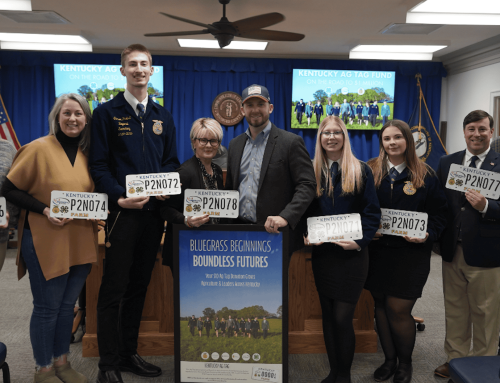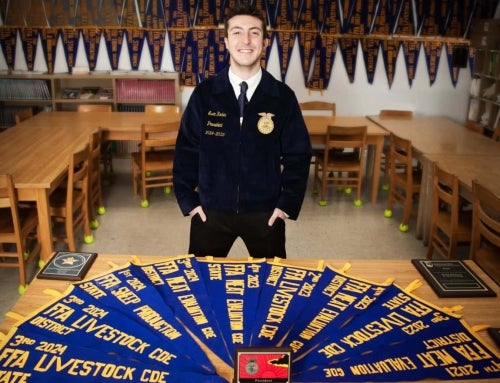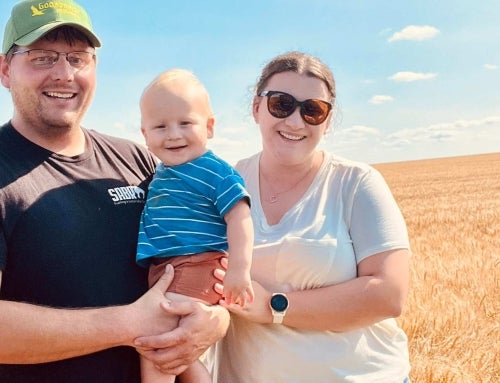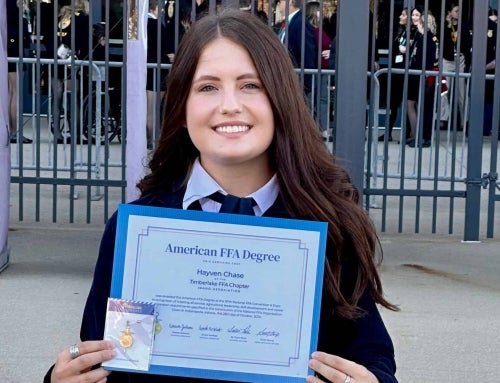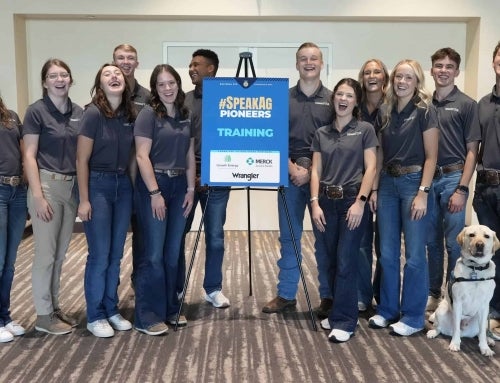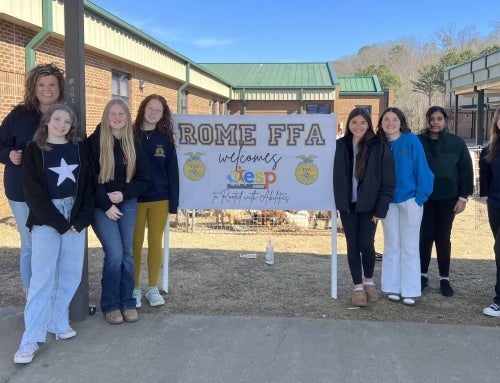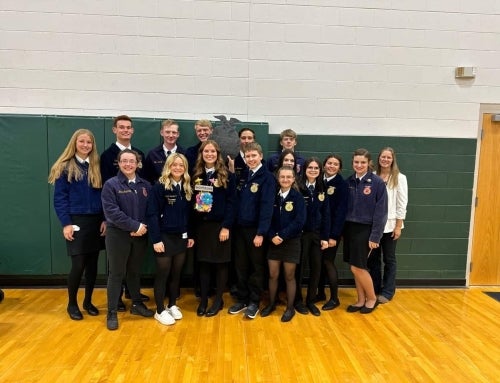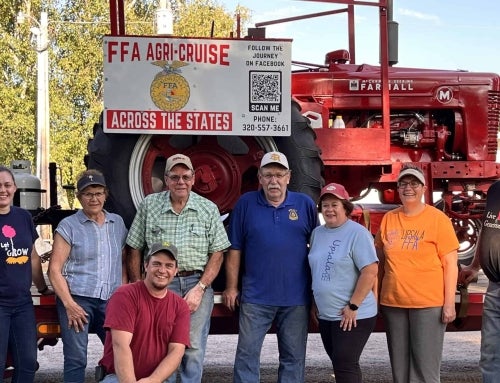In order to feed a hungry planet, future agriculturists have to think outside the box. For some students, this means working inside the AgroBox.
When you walk into a classroom at Bryan High School’s Urban Agriculture Academy, you see a typical teacher’s room. A bulletin board holds announcements and school notices. Bookcases are scattered around the room with resources and references for research papers. The loud sounds of lockers opening and closing fill the hallways between classes. It isn’t until you walk behind the school, in the middle of Omaha, Neb., that you see what turns a great agricultural education program into an innovative high school experience.

Samantha Hernandez inspects lettuce grown in the nutrient film technique (NFT) hydroponic system.
Turning the corner around the back of the building, you are greeted by an imposing 40-foot-long shipping container with murals painted on the sides. Once you pull open the doors of the container, you find it’s been completely refurbished to contain state-of-the-art equipment for growing lettuce, tomatoes and various herbs using hydroponics. This facility is known as the AgroBox, and it can produce up to 1 acre of fruits and vegetables in the space of six standard parking spaces.
“A few years ago, our school was looking to expand the agricultural program and career academies,” says Tyler Schindler, Bryan High School FFA advisor and agricultural education teacher. “We initially wanted to build a greenhouse, but we didn’t have the money or space needed for that type of project. Given those obstacles, the AgroBox became the perfect solution.”
The AgroBox won favor over a greenhouse, as it is a nonpermanent, modular structure. The building can be loaded up and moved to a different location if needed. Once the idea for the agricultural education shipping container was formed, the school contacted Rubicon Agriculture, a manufacturing company based in Indiana, to make a game plan for creating the facility. Chris Moorman, an owner of Rubicon Agriculture, was a former FFA member and saw incredible potential in the project. After building plans were in place, the school secured funding from the Omaha School Foundation, its Perkins budget (which provides funding for career and technical education), Farm Credit Services, and the Buffett Foundation to make this dream come alive.

Joslyn Wildrick inspects herbs that were planted in the ebb and flow hydroponic system.
“Our focus has been to give students the experience of working in a greenhouse setting and also to learn what urban agriculture is all about,” Schindler says.
“There aren’t many opportunities to work in the greenhouse industry in the middle of Omaha, but there is a growing demand for urban agriculture, community gardens, and locally grown food. There has been a lot of focus on how to grow your own food in your house or in your yard. This is what we focused on rather than bedding plants and flowers. What we try to do in the AgroBox is really about the research experience and the different things that impact growing.”
The Science Behind the Food
When working in the hydroponics facility, students control the lighting, temperature, humidity and more. Making small changes allows the students to measure the impact that each of the variables has on the growth rates of plants. The school is set up in the career academy model, so students can then take this data into their science and math classes to measure and plot the data to make informed, science-based decisions for their projects.

Kevin Salazar refills a nutrient tank, which can be programmed to dispense nutrient solutions in selectd quantities.
“The success of the AgroBox is a collaborative group effort rather than the work of one single teacher or one single person,” Schindler says. “I work with a history teacher, a science teacher, a math teacher, an English teacher, and a special education teacher every week to talk about our students and the work that is coming up. We also work with a curriculum director and a counselor to make sure all of our students’ needs are met. Our principal is also a big driver of getting kids real-world experiences. I rarely have a student ask me, ‘When am I ever going to use this?’ They can immediately see how it connects to their future.”
The program has become increasingly popular. In the first year, 90 students were able to work in the AgroBox. Today, the Urban Agriculture and Natural Resources Career Academy enrolls 170 students. The program is highly selective and has to turn away nearly 40 percent of students who apply to be in the academy.
Even still, Bryan High School supports one of the largest FFA chapters in the state of Nebraska with more than 100 active members. As agricultural education programs continue to expand and thrive in urban areas, it is becoming increasingly important for students to understand where their food comes from and how the entire food chain works. For many students in the Omaha school district, basic literacy on what food is and how it is grown may not always be available.

Schindler shows Kevin Salazar how to use a donated growing chamber in order to start plugs and plants for the hydroponic systems.
“We have a lot of food processing companies in and around Omaha,” Schindler says. “These companies make and produce a huge amount of the food in our grocery stores, but our students didn’t even know that. Now, every incoming student in our academy takes part in a rural immersion field trip.”
As a part of this field trip, each student is required to select a favorite food and trace its path from the farm to the dinner table. For example, if a student chooses to study popcorn, he or she may visit a popcorn grower to see the crop in the field and learn how popcorn is harvested, processed, transported, and eventually how it ends up as a bag of kernels that can be cooked in the microwave.

Kassie Ronnei and Joslyn Wildrick check on their cuttings. The students use the wall aeroponics system to clone and root plants.
The Future of Food Production
The AgroBox is just one example of innovative food-production facilities that can be used in urban communities to save resources and space and to provide locally grown produce.
“It is amazing how this one shipping container has had such an immense impact on our students, our school and the communities in which we work,” Schindler says. “This is my third year as a teacher at Bryan High School, and I know it will only continue to grow. This year, we have a chapter officer team that is going full force. Our teachers are focused on providing even more programming to keep the students engaged. We have a state officer from our chapter this year, which has had a huge impact on our chapter, school and city. And this year, we have added a second agricultural education teacher to the program to keep up with the demand. We have truly transformed the lives of our students.”
Curriculum Across Classrooms
When an agricultural education program is structured in the career academy model, students learn how foundational courses, such as algebra, biology and English, are used in the agriculture industry. From calculating feed ratios for cattle to developing agritourism business plans, all careers in agriculture require proficiency in reading, writing nand arithmetic. At Bryan High School, freshman students make a career academy choice and take classes such as agricultural biology, agricultural economics, agricultural English, food science, agribusiness and agricultural American government during their sophomore, junior and senior years.
This allows students and FFA members to see the connection between classes in a field they are interested in. Students working on a prepared public speaking leadership development event can receive support from their English teachers. Students studying for the farm business management contest can immediately use the skills learned in agricultural economics and American government when preparing for exams. In algebra classes, they can calculate parts-per-million formulas for various concentration and dilution ratios of plant products. Students who are putting together an agriscience fair presentation can gather feedback and advice from science teachers. Career academy models have shown an increase in student engagement, graduation rates and attendance across the country, according to the National Career Academy Coalition.



